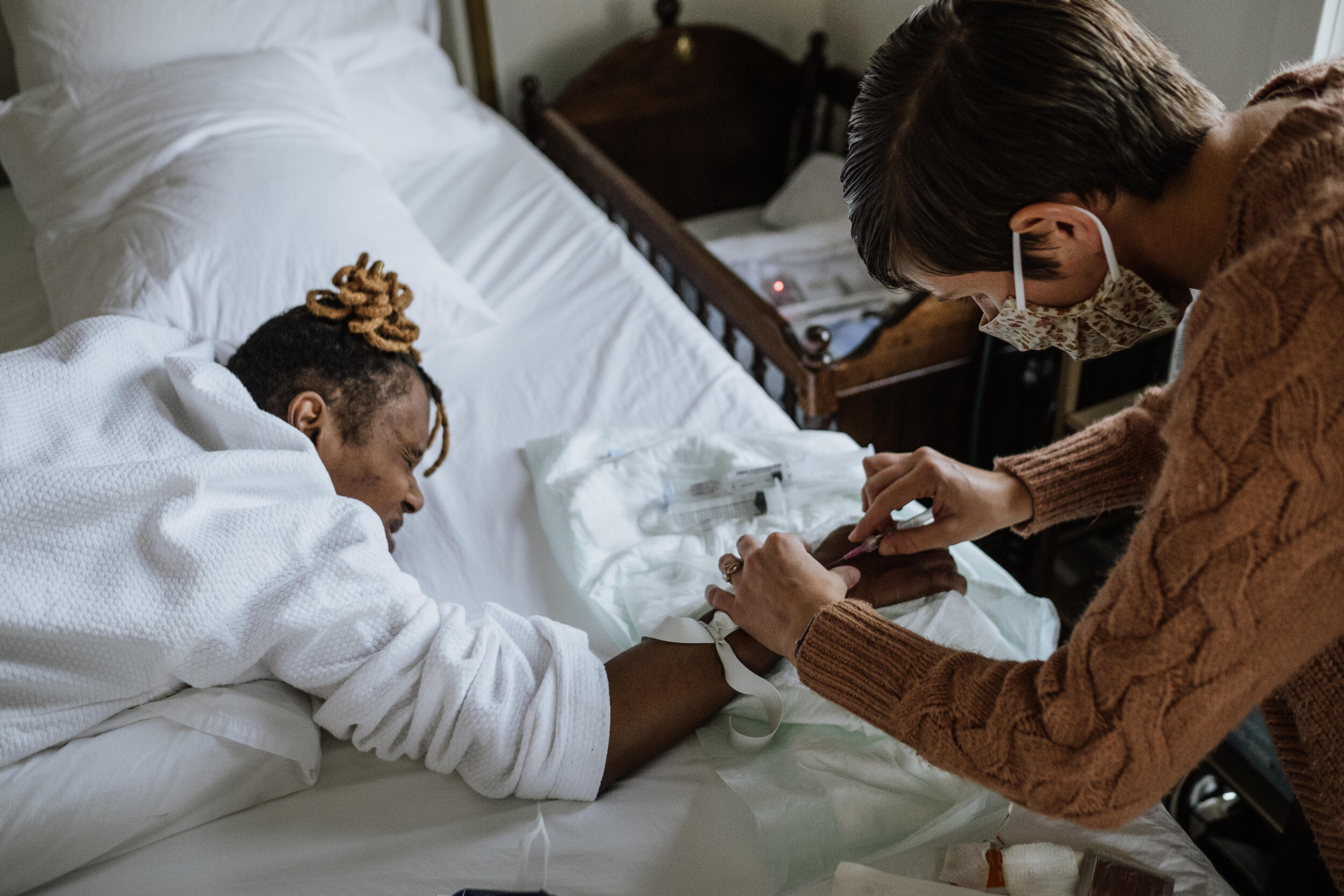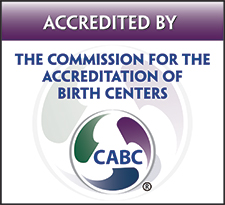July is International Group B Strep Awareness Month. If you’ve never been pregnant or if this is your first pregnancy, chances are you haven’t heard of Group B Strep before now. Also known as Group B Streptococcus, Beta Strep, Strep B or simply abbreviated to GBS, most people in the United States are screened for this bacteria during their pregnancies because of the slight risk that their babies will be infected with GBS during the birth process. Although the medical model often views a positive GBS status as an indicator of a high-risk birth – that can disrupt your carefully laid plans for labor – in the midwifery model of care, we consider being GBS-positive a variation of normal. Screening and treatment for prevention of newborn GBS infection are easily accomplished in the community birth setting!
GBS is a common bacteria that can be found in people of all ages. It is one of the leading causes of meningitis, pneumonia, and sepsis. GBS doesn’t always make people sick, though. The bacteria resides in the gut and migrates down to the rectum, vagina, and urinary tract. At any given time, 10-30% of pregnant people around the world are “colonized” with GBS. This means they carry the bacteria somewhere in their bodies. Most people who are colonized with GBS do not develop an infection or have any symptoms.
GBS can, however, cause serious illness in newborns. There are 2 main types of GBS infection in newborns: early onset, which develops in the first 7 days of life and late onset, which develops after 7 days of life. Early onset infection is usually caused by transmission of bacteria during birth, while late onset is typically caused by transmission after the baby is born. Nearly all babies with an early onset GBS infection will start showing symptoms within 24-48 hours of their birth.
Early infections happen due to the direct transfer of GBS bacteria from the laboring person to their baby during the birth process. This usually occurs after the water breaks. GBS bacteria can travel up from the vagina into the amniotic fluid. If the baby ingests some of the amniotic fluid into their lungs, it can lead to an early GBS infection. Another way that GBS can be passed from parent to baby is through their skin and mucous membranes as they move down the birth canal. Most babies who are “colonized” in this way do not develop an infection. *Luckily, antibiotics can kill this bacteria. Without antibiotic treatment during labor for someone who is GBS-positive, the baby’s risk of becoming colonized with the bacteria is about 50% and the risk that they will develop a life-threatening GBS infection is 1-2%. With antibiotic treatment during labor, this risk goes down to 0.2%.
Although rare, early GBS infection in newborns can cause serious illness that requires extensive hospital stays in the NICU and can lead to long term health problems. Researchers have found that up to 44% of babies who survive meningitis caused by GBS have ongoing issues including developmental delays, paralysis, seizure disorders, hearing or vision loss, and small brains. The death rate of full-term infants who develop early GBS infection has been found to be 2 to 3%. In other words, of every 100 babies who actually develop an early GBS infection (as opposed to those who are just “colonized” with GBS), 2 to 3 will die.
Since the early 1990s, both the American Congress of Obstetricians and Gynecologists (ACOG) and the American Academy of Pediatrics (AAP) have recommended GBS screening for all pregnant people in the United States and treating people who screen positive for GBS with IV antibiotics during labor. Since these recommendations were made, the rate of early GBS infections has dropped dramatically, from 1.7 infections per 1,000 births to 0.25 infections per 1,000 births in the U.S. today.
Typically, clients are screened for GBS infection using a culture test between 35 and 37 weeks of pregnancy. A Q-tip is used to gently swab the vagina and rectum, and is sent to a lab to see if the bacteria grows. Results usually take about 48 hours. Occasionally, pregnant people are tested for GBS via a urine sample early in their pregnancy. Most of our clients at Fika are most comfortable doing their own swab in the bathroom at their 36 week prenatal visit.
Labor and birth care for people who screen positive for GBS during their pregnancies can look different based on their specific needs and desires. The most common form of treatment to prevent early GBS infection in newborns is IV antibiotics every 4 hours during labor. Usually the antibiotic of choice is penicillin, unless the pregnant person has an allergy, in which case an appropriate alternative would be used. Universal screening and antibiotics during labor for everyone who screens positive is the protocol recommended by ACOG, AAP, the Centers for Disease Control (CDC), the American College of Nurse-Midwives (ACNM), and the American Academy of Family Physicians (AAFP).
At Fika, if you opt for this treatment protocol, you will come into the Coit House to get your first dose of antibiotics as soon as possible after your water breaks. From then on, you will receive antibiotics every 4 hours. You return home if you are early in your labor and come back to the Coit House when your next dose is due. A saline lock will remain in place, but you won’t be tied to an IV throughout your labor. With antibiotic treatment in the community birth setting, you will still be able to move freely, eat and drink what you want, and labor and birth in the water.
You can also choose to use a risk-based approach to early GBS infection prevention, whether or not you screened positive for the bacteria. While not recommended in the U.S., this protocol is the standard of care in other countries such as the United Kingdom and New Zealand. With this option, you will be offered antibiotics if you meet certain risk criteria, such as having a baby before 37 weeks, having your water broken for longer than 18 hours, developing a fever during labor, having GBS present in a urine sample at any point in pregnancy, or having had a prior infant with GBS infection.
Our philosophy of shared decision making means that you can pick the best course of prenatal and birth care for you and your family and that you can change your mind at any point. If being tested for GBS during your pregnancy wouldn’t change the choices you make in labor, you can decline the screening. Likewise, if you screen positive for GBS but do not want to receive IV antibiotics during labor, that is your right. Some reasons people may choose to decline treatment include: the discomfort of having an IV in place, the potential for allergic reactions, or the possible side effects of antibiotics for the pregnant person and their baby, like yeast infections and thrush.
If you want to take steps to prevent a positive GBS screen, try adding a probiotic supplement to your daily routine or eating more fermented foods like yogurt, kefir, kombucha, sauerkraut, pickles, miso, tempeh, kimchi, and sourdough bread. There is some very promising evidence that incorporating probiotics into your wellness routine can decrease the rate of GBS colonization in pregnant people, and can even help someone change their GBS status after a positive screening.
Our goal is to ensure all of our clients know their complete range of options and have all the evidence they need to make informed decisions. Check out this excellent article from Evidence Based Birth that goes through all of the current research on Group B Strep. If you have questions about GBS infection, screening, or treatment, don’t hesitate to ask the midwife at your next visit!
Author Mary Badame is the Quality Assurance Manager at Fika Midwifery and is a passionate advocate for midwife-led care, increased birth options, and better reproductive healthcare for everyone.




